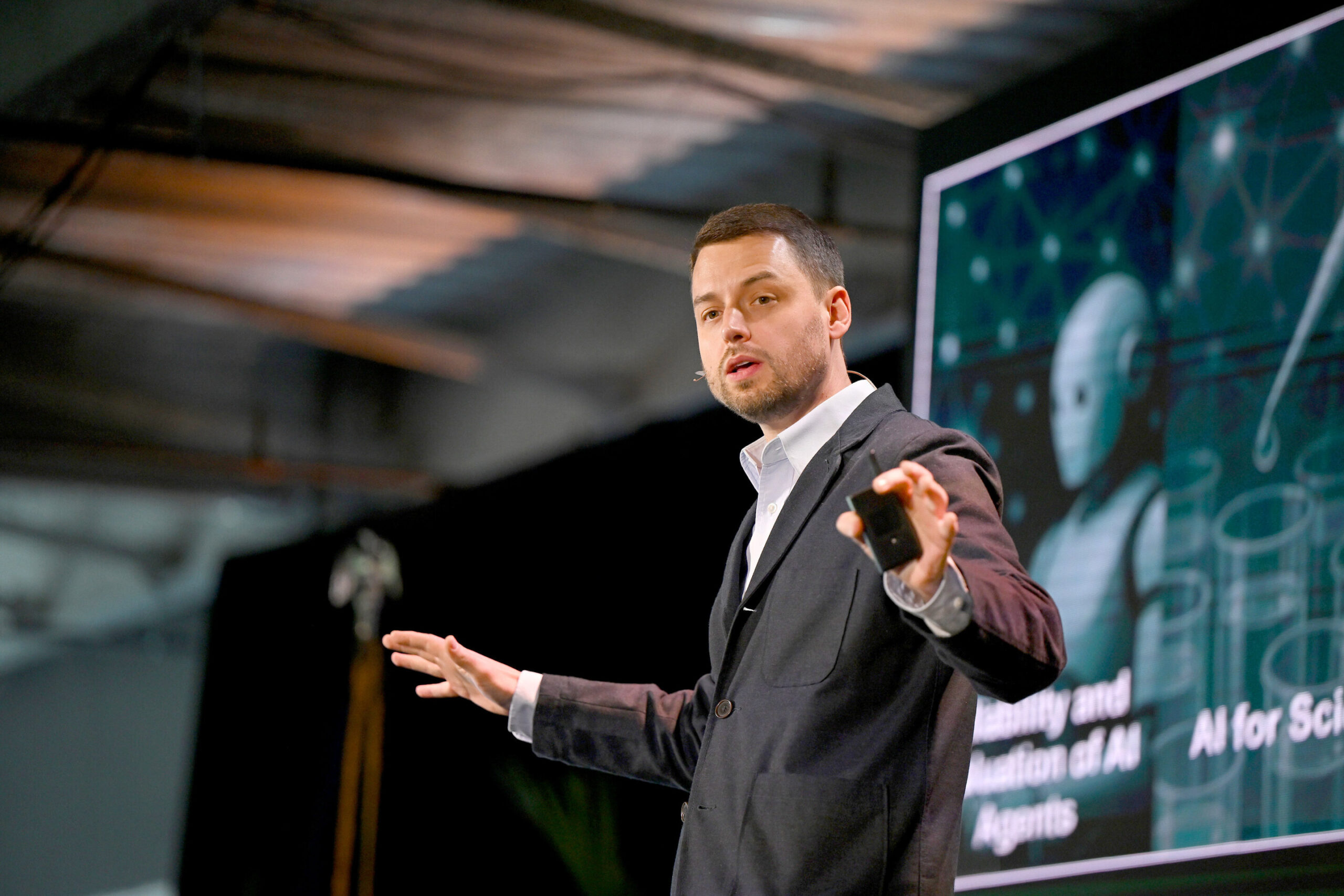Tech
Who is Zico Kolter? A professor leads OpenAI safety panel with power to halt unsafe AI releases

If you believe artificial intelligence poses grave risks to humanity, then a professor at Carnegie Mellon University has one of the most important roles in the tech industry right now.
Zico Kolter leads a 4-person panel at OpenAI that has the authority to halt the ChatGPT maker’s release of new AI systems if it finds them unsafe. That could be technology so powerful that an evildoer could use it to make weapons of mass destruction. It could also be a new chatbot so poorly designed that it will hurt people’s mental health.
“Very much we’re not just talking about existential concerns here,” Kolter said in an interview with The Associated Press. “We’re talking about the entire swath of safety and security issues and critical topics that come up when we start talking about these very widely used AI systems.”
OpenAI tapped the computer scientist to be chair of its Safety and Security Committee more than a year ago, but the position took on heightened significance last week when California and Delaware regulators made Kolter’s oversight a key part of their agreements to allow OpenAI to form a new business structure to more easily raise capital and make a profit.
Safety has been central to OpenAI’s mission since it was founded as a nonprofit research laboratory a decade ago with a goal of building better-than-human AI that benefits humanity. But after its release of ChatGPT sparked a global AI commercial boom, the company has been accused of rushing products to market before they were fully safe in order to stay at the front of the race. Internal divisions that led to the temporary ouster of CEO Sam Altman in 2023 brought those concerns that it had strayed from its mission to a wider audience.
The San Francisco-based organization faced pushback—including a lawsuit from co-founder Elon Musk—when it began steps to convert itself into a more traditional for-profit company to continue advancing its technology.
Agreements announced last week by OpenAI along with California Attorney General Rob Bonta and Delaware Attorney General Kathy Jennings aimed to assuage some of those concerns.
At the heart of the formal commitments is a promise that decisions about safety and security must come before financial considerations as OpenAI forms a new public benefit corporation that is technically under the control of its nonprofit OpenAI Foundation.
Kolter will be a member of the nonprofit’s board but not on the for-profit board. But he will have “full observation rights” to attend all for-profit board meetings and have access to information it gets about AI safety decisions, according to Bonta’s memorandum of understanding with OpenAI. Kolter is the only person, besides Bonta, named in the lengthy document.
Kolter said the agreements largely confirm that his safety committee, formed last year, will retain the authorities it already had. The other three members also sit on the OpenAI board—one of them is former U.S. Army General Paul Nakasone, who was commander of the U.S. Cyber Command. Altman stepped down from the safety panel last year in a move seen as giving it more independence.
“We have the ability to do things like request delays of model releases until certain mitigations are met,” Kolter said. He declined to say if the safety panel has ever had to halt or mitigate a release, citing the confidentiality of its proceedings.

Kolter said there will be a variety of concerns about AI agents to consider in the coming months and years, from cybersecurity—”Could an agent that encounters some malicious text on the internet accidentally exfiltrate data?”—to security concerns surrounding AI model weights, which are numerical values that influence how an AI system performs.
“But there’s also topics that are either emerging or really specific to this new class of AI model that have no real analogues in traditional security,” he said. “Do models enable malicious users to have much higher capabilities when it comes to things like designing bioweapons or performing malicious cyberattacks?”
“And then finally, there’s just the impact of AI models on people,” he said. “The impact to people’s mental health, the effects of people interacting with these models and what that can cause. All of these things, I think, need to be addressed from a safety standpoint.”
OpenAI has already faced criticism this year about the behavior of its flagship chatbot, including a wrongful-death lawsuit from California parents whose teenage son killed himself in April after lengthy interactions with ChatGPT.
Kolter, director of Carnegie Mellon’s machine learning department, began studying AI as a Georgetown University freshman in the early 2000s, long before it was fashionable.
“When I started working in machine learning, this was an esoteric, niche area,” he said. “We called it machine learning because no one wanted to use the term AI because AI was this old-time field that had overpromised and underdelivered.”
Kolter, 42, has been following OpenAI for years and was close enough to its founders that he attended its launch party at an AI conference in 2015. Still, he didn’t expect how rapidly AI would advance.
“I think very few people, even people working in machine learning deeply, really anticipated the current state we are in, the explosion of capabilities, the explosion of risks that are emerging right now,” he said.
AI safety advocates will be closely watching OpenAI’s restructuring and Kolter’s work. One of the company’s sharpest critics says he’s “cautiously optimistic,” particularly if Kolter’s group “is actually able to hire staff and play a robust role.”
“I think he has the sort of background that makes sense for this role. He seems like a good choice to be running this,” said Nathan Calvin, general counsel at the small AI policy nonprofit Encode. Calvin, who OpenAI targeted with a subpoena at his home as part of its fact-finding to defend against the Musk lawsuit, said he wants OpenAI to stay true to its original mission.
“Some of these commitments could be a really big deal if the board members take them seriously,” Calvin said. “They also could just be the words on paper and pretty divorced from anything that actually happens. I think we don’t know which one of those we’re in yet.”
© 2025 The Associated Press. All rights reserved. This material may not be published, broadcast, rewritten or redistributed without permission.
Citation:
Who is Zico Kolter? A professor leads OpenAI safety panel with power to halt unsafe AI releases (2025, November 2)
retrieved 2 November 2025
from https://techxplore.com/news/2025-11-zico-kolter-professor-openai-safety.html
This document is subject to copyright. Apart from any fair dealing for the purpose of private study or research, no
part may be reproduced without the written permission. The content is provided for information purposes only.
Tech
Americans Are Increasingly Convinced That Aliens Have Visited Earth

Americans are becoming more open to the idea that aliens have visited Earth, according to a series of polls that show belief in alien visitation has been steadily on the rise since 2012.
Almost half—47 percent—of Americans say they think aliens have definitely or probably visited Earth at some point in time, according to a new poll from YouGov conducted in November 2025 that involved 1,114 adult participants. That percentage is up from roughly a third (36 percent) of Americans polled in 2012 by Kelton Research, with the exact same sample size. Gallup published polls on this question in 2019 and 2021 that likewise show an upward trend.
Moreover, people seem to be getting off the fence on this issue, one way or the other. Just 16 percent of Americans said they were unsure if aliens had visited Earth in the new poll, down from 48 percent who were unsure in 2012. Meanwhile, even as belief in alien visitation has risen, so has doubt: The new poll shows that 37 percent of Americans said Earth likely hasn’t been visited by aliens, more than double the 17 percent logged in 2012.
It’s impossible to know exactly why Americans have become more receptive to alien visitation from these polls alone; they only include raw statistics, and lack granular details about the specific motivations for the participants’ responses.
“It’s important to note that this is a poll about belief,” says Susan Lepselter, an author and associate professor of anthropology and American Studies at Indiana University who has written extensively on alien beliefs and UFO experiences. “It’s not a poll about experience, contact, feelings—nothing like that.”
“We don’t know what their engagement is; we don’t know if their belief has been life-changing,” she adds. “We just know one thing, which is that the statistics have moved from one set of beliefs to another.”
Of course, it’s still possible—and let’s be real, fun—to speculate on the drivers of the trend. One obvious culprit is a new posture from institutional news sources, such as the US government and legacy media, which have finally started taking unidentified anomalous phenomena (UAP) seriously.
This shift began with the release of mysterious Pentagon UAP videos by The New York Times in 2017, and has since been accelerated by spate of Congressional hearings, and a NASA independent study on UAP. The newly released documentary The Age of Disclosure, which features claims by former military officials that the US government has covered up evidence of aliens visiting Earth, has supercharged the legitimacy to this once marginalized topic.
Tech
Get Up to 50% Off Select Items With These Ring Camera Deals

If you’re a fan of Amazon’s ecosystem, whether that’s asking your Alexa speaker to tell you about the weather or compulsively checking the video feed from your Ring doorbell, then it makes sense to expand and build onto the system. It’s always easier to keep to one ecosystem as much as you can with smart home gear, letting you stick to a single app and single subscription if you decide to invest in one.
While we’ve liked Ring’s cameras and home security products fine enough, they’re hard to recommend at the top of our guides since Ring is reintroducing a policy to enable local law enforcement to request footage directly from Ring users. It’s up to you if that’s something you want to invest in, and if you already have Ring products, it might make the most sense to continue adding onto that ecosystem than diving into a new one.
No matter the reason, if you’re looking to add a Ring product to your home, don’t get one without using our Ring coupon codes to get it for a better price.
50% Off Ring Cameras, Doorbells, and Outdoor Cameras
Ring is running a deal all month long with up to 50% off different products and bundles. You can get all kinds of Ring cameras and security accessories for a variety of discounts, from Ring’s video doorbell to indoor and outdoor cameras.
Save $150 on Wired Doorbell Pro and Floodlight Cam
If you’re looking for an outdoor combination, you can get both Ring’s Starter Pro Kit, which includes the Wired Doorbell Pro and Floodlight Cam, for $150 off the set. It’s a great option if you want to get a camera feed both at your doorstep and over your garage.
Bundle and Save on Ring Whole Home Basic Kit
Looking to deck out your whole home? Ring’s Whole Home Basic Kit is also discounted for $59 off. It includes Ring’s Outdoor Cam Plus Battery, Battery Doorbell, and the Alarm Security Kit, so you can get everything from video surveillance around the outside of your home and sensors to pair with the alarm system for inside of it.
Ring has a variety of subscription plans, which you’ll want since there’s no option to locally store your video footage. That means in order to play any video back to see what set off the camera or who was at the door, you’ll need one of these plans. Here’s a quick breakdown. Basic Ring Plan: Get the basics with video event playback and smart notifications for one camera. $5 per month or $50 per year. Standard Plan: All the core Ring experience with enhanced features for all your devices. $10 per month, or $100 per year. Premium Plan: Ring home the best of the best with our most advanced AI and recording features. $20 per month or $200 per year.
Stay Connected With $29 Off Pet Basic Kit + Pet Tag
Ring has a pet package you can get for a discount, too. You’ll get both Ring’s Indoor Cam and the Pet Tag, which has a QR code that lets anyone who finds your pet scan it and get your information to contact you. It’s 50% off right now, so if you’re looking for new tags and a camera to keep an eye on your favorite furry companion, this is your moment.
Tech
UK mobile improves but digital divides persist | Computer Weekly

Mobile connectivity across the UK is becoming faster and more responsive on average; a marked gap still persists between the quality of experience in urban and rural areas; and the gap between the best and worst-performing local authorities remains significant, according to research from Ookla.
The analyst’s Speedtest Intelligence report for 2025 takes an overview of mobile network performance across the UK, focusing on outcomes at local authority level and how those outcomes have changed over time.
The study was based on millions of samples from mobile devices connected to a cellular network, comparing results from Q1–Q3 2025 with the same period in 2024. For each local authority, the report considered not only typical speeds, but also the experience of slower connections, and the relationship between population density and mobile outcomes. At UK and country (nation) level, it drew on national aggregate metrics (2025 to date) for the UK, England, Scotland, Wales and Northern Ireland.
Fundamentally, the research found that population density correlates strongly with better outcomes, and that practically, the findings illuminate the urban-rural digital divide, showing that where you live in the UK largely dictates your mobile experience.
Analysis of local authority outcomes revealed what Ookla called the “stark” extent of regional variation in and across nations in the UK. Despite the general upward shift in the overall local authority distribution over the past year across key mobile performance indicators, the range remains large and many rural local authority areas are still stuck with not-spots despite the progress of the government’s shared rural network (SRN) scheme. Areas that were strong performers in 2024 generally remained strong, and many of the weakest authorities in 2024 still sit near the bottom of the distribution in 2025.
On a country level, UK mobile performance improved notably between 2024 and 2025, with the national median download speed rising from approximately 55.02Mbps to 63.03Mbps. This represented a year-on-year increase of around 15%. Median upload speeds inched up from 7.80Mbps to 8.21Mbps, while median latency improved marginally from 52ms to 50ms.
England and Northern Ireland saw the strongest gains, while Wales remained the slowest nation and Scotland’s median slipped from 49.13 to 46.05Mbps despite improvements in several local authorities. Overall, though, the UK rates badly compared with European peers such as Germany and the Republic of Ireland.
Drilling deeper, the study showed that the gap between local authorities remained stark. In Q1–Q3 2025, median speeds ranged from just over 10Mbps in the Shetland Islands to just over 100Mbps in Leicester. Around 28% of local authorities had fewer than 60% of test samples meeting a 25Mbps download threshold, indicating persistently poor connectivity for many in the UK.
Including the aforementioned Leicester, top performers included Nottingham, Derby, Bridge of Don, Thurrock and Stoke-on-Trent. These areas typically combine median download speeds in the mid-80s to 100Mbps, roughly three-quarters or more of samples reaching 25Mbps, and relatively strong results even in the slowest 10th percentile (generally around 8–11Mbps).
In addition to the Shetland Islands, the country’s weakest performers included the Isle of Anglesey, Fermanagh and Omagh, Denbighshire, Pembrokeshire, Orkney, and Cornwall. These areas have median download speeds mostly in the mid-teens to low-20s – excluding the Shetland Islands – with less than half of samples reaching 25Mbps and 10th-percentile speeds typically in the 1.5–3Mbps range, highlighting large not-spots for a significant share of users there.
Looking at the companies driving the industry, the study noted that heavy capital spending by the UK’s operators was driving improved outcomes. It added that the UK remains one of only a handful of countries in Europe and globally where at least three operators have “aggressively” deployed 5G standalone across a significant footprint.
Virgin Media O2 has already reported 70% population coverage and BT/EE boasts a similar level. VodafoneThree has committed to invest £11bn in its UK network over the next decade, including £1.3bn of capex in year one.
-

 Business6 days ago
Business6 days agoHitting The ‘High Notes’ In Ties: Nepal Set To Lift Ban On Indian Bills Above ₹100
-

 Politics1 week ago
Politics1 week agoTrump launches gold card programme for expedited visas with a $1m price tag
-

 Business1 week ago
Business1 week agoRivian turns to AI, autonomy to woo investors as EV sales stall
-

 Fashion1 week ago
Fashion1 week agoTommy Hilfiger appoints Sergio Pérez as global menswear ambassador
-

 Sports1 week ago
Sports1 week agoPolice detain Michigan head football coach Sherrone Moore after firing, salacious details emerge: report
-

 Business1 week ago
Business1 week agoCoca-Cola taps COO Henrique Braun to replace James Quincey as CEO in 2026
-

 Tech1 week ago
Tech1 week agoGoogle DeepMind partners with UK government to deliver AI | Computer Weekly
-

 Sports1 week ago
Sports1 week agoU.S. House passes bill to combat stadium drones


















